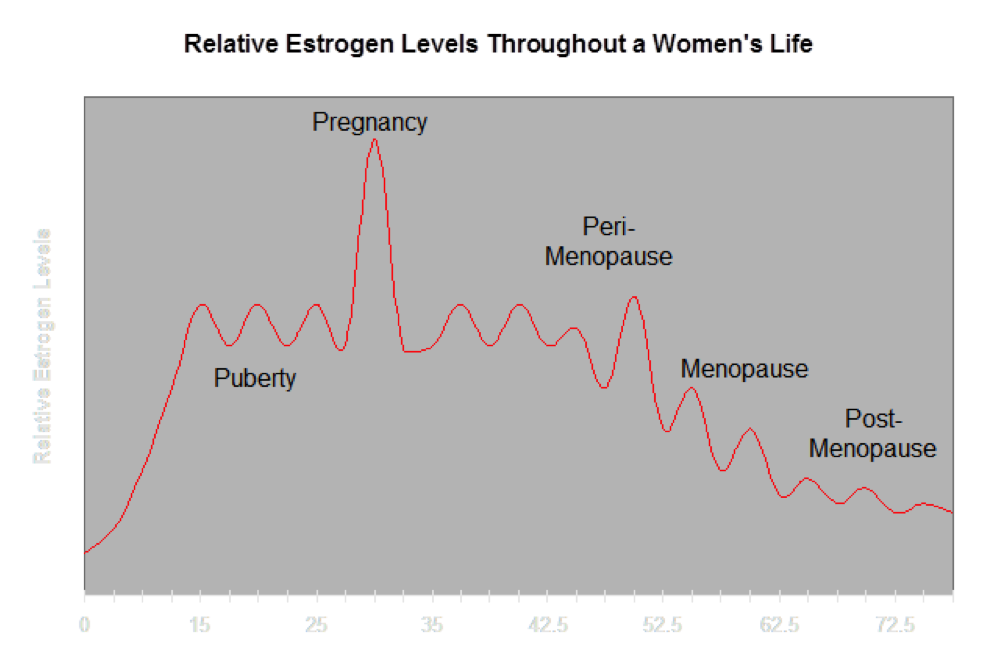Perimenopause is the time period preceding the cessation of normal menstrual periods; this typically occurs sometime between 35 and 50 years of age. It is often thought that hormone levels decline uniformly during this time and that the symptoms associated with perimenopause and menopause are due solely to a decrease in sex hormones. Unfortunately, this is not the case. During this time, hormone levels (especially estrogen) can fluctuate wildly before finally settling at lower-than-previous levels, as the chart below details:
Perimenopause typically lasts one to two years, but can span as much as ten years depending upon your unique physiology and circumstances. During this time, progesterone levels are also fluctuating and declining. In fact, a woman in her 40s or 50s may experience a decrease or even cessation in progesterone production during many of her menstrual cycles due to a lack of regular, consistent ovulation and the aging of her ovaries. This can cause a number of sex hormone imbalances, which can lead to many of the symptoms associated with perimenopause.
Changes in the Ovaries
As the ovaries age, they undergo physical and structural changes. They begin to shrink and become less responsive to the chemical messengers sent by the brain (specifically the hormones luteinizing hormone (LH) and follicle-stimulating-hormone (FSH)). Thus communication begins to break down and the ovaries stop listening to the signals the brain is sending.
Additionally, as a woman ages, she has fewer eggs available to mature, and the eggs she does have are older and less responsive. This situation often prevents a follicle from maturing enough to expel the egg (i.e., ovulation does not occur). When this happens, the second half of the menstrual cycle (the luteal phase) never kicks in, so progesterone isn’t produced, resulting in low progesterone levels. Meanwhile, estrogen is fluctuating from unusually high to unusually low. The result is an almost constant state of sex hormone imbalance known as estrogen dominance.
Estrogen Dominance
Estrogen dominance is often the cause of symptoms women experience during perimenopause. Although we typically only think about the sex organs when it comes to estrogen & progesterone, hundreds of tissues in your body have receptors for these hormones including the uterus, breasts, blood vessels, brain, bones and heart. Therefore, the health of all these tissues is dependent upon the balance between estrogen and progesterone.
Restoring Balance
Your body does it’s best to restore the balance between estrogen and progesterone by increasing the brain’s signals in an attempt to stimulate ovulation (i.e., it increases the number of chemical messengers (LH and FSH) it sends to the ovaries to try and reestablish communication). However, this only works temporarily, and as perimenopause progresses, it becomes harder and harder for the body to ovulate. The good news is that relief is possible and it doesn’t require drugs.
The trick is to bring the levels of estrogen and progesterone back into balance. When they are balanced you will no longer experience symptoms and you will be able to enjoy your life and those around you to the fullest extent possible.
To alleviate perimenopausal symptoms and restore hormonal balance safely and naturally, all we need to do is gently reduce your body’s own estrogen production and increase progesterone levels by encouraging ovulation. This minimizes estrogen’s effect on your tissues by reducing its ability to bind to tissue receptors and optimizing the body’s ability to breakdown and eliminate estrogen.
We have developed a Hormone Balancing Diet to help in this regard; click here to learn more or to purchase the Hormone Balancing Diet.



